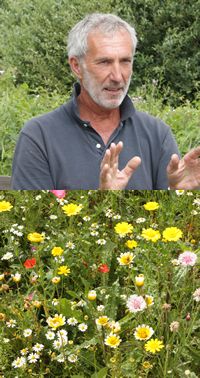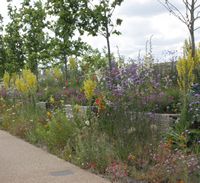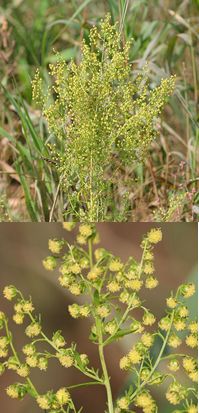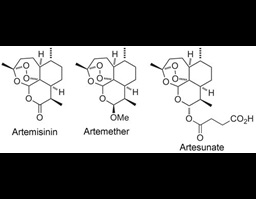On 18 July the Group joined with the Professional Horticulture Group South West to visit the The Field of Dreams at Barcroft Hall, South Petherton, Somerset details of which appear below. The Group then went on to nearby East Lambrook Manor to visit the garden created by garden writer Margery Fish.
On July 24 the Group visited the Deanery of Canterbury Cathedral and its gardens before moving to Edward Vinson's soft fruit farm to learn about their soft fruit breeding programme for strawberries, blackberries and blueberries. A full report on these visits will appear in the September Newsletter.
On Friday 19 September we will be holding our Annual General Meeting at our newly refurbished building in Belgrave Square. Immediately after the AGM we will have presentations from this year's David Miller Award winners as well as updates from last year's winner. All Members of the Group are welcome.
Peter Grimbly
Contents
Fields of Dreams
Plant of the Month
News from our Associates
Horticulture Industry News
Events Calendar
Horticulture Group contact details
Related Links
Fields of Dreams
Last month I described the mammoth preparation work that preceded the building of the Olympic Park and, in particular, the perennial flower meadows that were planted to create a colourful and relaxing atmosphere for visitors.
By contrast, this last month, in conjunction with the Professional Horticulture Group South West, we visited the Field of Dreams at Barcroft Hall, South Petherton in Somerset. This is a flower meadow of annual flowers sown afresh each year. It has been created each year since 2011 with one exception by Brian and Louise Herrick.

The Somerset Field of Dreams being an annual meadow requires careful soil preparation; shallow ploughing to about 9in (230mm) followed by harrowing, sowing and subsequent rolling. Sowing is a challenge due to the small and variable size of the seed and owner, Brian Herrick (pictured top right), has solved this in an ingenious way. The seed is mixed in small batches with vermiculite or peat and then sown using a quad-bike and slug-pellet distributor once the soil temperature has reached 5oC - usually in the first week of April.
The soil preparation and sowing are very weather dependent and the wet spring of 2013 made sowing impossible for that year. Better conditions in 2014 had still left their mark as the final rolling on damp soil had left tractor depressions which were showing up as waves in the otherwise uniform height of the meadow.
This uniform height is a distinctive feature of this meadow (pictured lower right). The majority of plants range between 6in (150mm) and 18in (450mm) in height and despite the range of some 46+ species that are included the meadow is still only at its best for around 8 weeks in July and August.

The northern section of the Olympic Park is a more subdued and generally lower carpet of native species. Despite the careful soil preparation described last month, the vagaries of the English climate meant the establishment was not always uniform. Impatience by the park authorities resulted in a few areas being hastened by the importation of wildflower turf. These now stand out as rather uninteresting patches dominated by grasses which have smothered the few wildflowers within. While the intended sowings, now fully established are a solid carpet of wild flowers.
The whole objective in the Park was to create low maintenance plantings that required little more than an annual cut to keep them fresh. This simple culture plus the perennial nature of the species used means the next season may be advanced or delayed by seasonal weather variations but they will always recover to provide an annual spectacle.
Peter Grimbly
Plant of the Month
Artemisia annua L. (Asteraceae), Annual wormwood

In Artemisia annua all of the florets are of the same type; only under a hand-lens does each floret take on the appearance of a more familiar flower, with corolla, stamens and ovary being distinguished. The genus Artemisia includes economic plants such as Artemisia absinthium, the flavour of absinthe and vermouth, and Artemisia dracunculus, Russian tarragon. Like other Artemisia species, annual wormwood has highly aromatic leaves. The essential oils making up the particular aroma are stored in special glandular hairs (trichomes) covering the surfaces of the fern-like leaves, and other plant parts. The trichomes are also the storage site of an even more significant substance, artemisinin.
In the 1960s the Chinese government initiated a systematic investigation of the Chinese Materia Medica with the goal of identifying an anti-malarial medicine; such a medicine was found. Malaria is a threat to almost half of the World's population. Every year approximately 100 million people suffer from malaria and one million people die from the disease (predominantly African children). The parasite Plasmodium falciparum is responsible for the majority of these cases and is transmitted when female Anopheles mosquitoes, infected with the parasite, bite people.
Of all the hundreds of plants the Chinese tested, only annual wormwood was found to have any activity against the malarial parasite. Further investigation revealed the activity was due to artemisinin, the structure of which was determined in 1972. Artemisinin, and its more water-soluble derivatives artemether and artensunate, have become the treatments of choice for malaria. To delay the appearance of resistant malarial parasites, artemisinin-based treatments are always used in combination with other therapies. Artemisinin for medical purposes is grown worldwide but yields are low. A genetic map of annual wormwood has revealed loci affecting the yield of artemisinin. Such information is likely to be important for the genetic improvement of annual woodworm, especially the breeding of high artemisinin-producing plants.
Graham IA et al. 2010. The genetic map of Artemisia annua L. identifies loci affecting yield of the antimalarial drug artemisinin. Science 327: 328-331.
Hsu E 2010. Qinh hao (Herba Artemisiae annuae) in the Chinese Materia Medica. In: Hsu E & Harris S (eds) Plants, health and healing: on the interface of ethnobotany and medical anthropology. Berghahn Books, pp. 83-130.
Alison Foster
Oxford Botanic Garden
News from our Associates

The annual Naivasha Horticultural Fair will be held on Friday 19th & Saturday 20th September 2014 at the Naivasha Sports Club, Kenya. This highly important event is considered the biggest and most diverse horticultural fair for Kenya and the whole East African region. Following a successful first-time participation in 2010, CHA is planning to organise the first ever dedicated British Pavilion in 2014. Working alongside the British High Commission in Nairobi and with support from UKTI, they also have plans for an extended programme of activities, details of which will be announced shortly.
Following the Naivasha event, CHA will begin recruiting for Growtech Eurasia held in Antalya, Turkey between 3-6 December 2014. For further information on both shows contact CHA

The Society responded to the Department for Business Innovation and Skills consultation on Capital Investment in Science and Research, highlighting the need for a mixed portfolio of investment which is researcher-led and supported by funding for training, upkeep and resources. The full reponse can be viewed here.
Horticulture Industry News
For the very latest horticultural news follow us on Facebook,
Twitter, or
LinkedIn
Herbivores detoxify plants
Plants host a remarkable diversity of symbiotic fungi. Some of these, such as those associated with grasses, produce secondary metabolites that are intended to deter herbivores. Recent research shows that herbivores can directly combat this mutualistic interaction through compounds in their saliva. Experiments with endophytic fungi isolated from red fescue (Festuca rubra) found that colonies grew more slowly within 36 hours after being treated with moose and reindeer saliva but not water. In whole plants, saliva also seemed to deactivate defence signalling pathways. Plants from populations with inducible defences produced about 100% more of the toxic alkaloid ergovaline when experimentally clipped but nearly 70% less when saliva accompanied the simulated grazing. This now overturns the perception that animals simply avoid or detoxify toxins, and suggests they can actively combat plant defenses. More
Urban heat boosts pest populations
New research shows that urban heat islands are slowly killing red maples (Acer rubrum) in the southeastern United States. One factor is that researchers have found warmer temperatures increase the number of young produced by the gloomy scale insect (Melanaspis tenebricosus) - a significant tree pest - by 300 percent, which in turn leads to 200 times more adult gloomy scales on urban trees. These findings also raise concerns about potential pest outbreaks as temperatures increase due to global climate change. More
A new seedless mango
Mangoes are an excellent source of calcium, vitamins A and C, antioxidants and potassium. But eating one often results in a huge mess - the seed is just too big and because of that one usually ends up with mango stains everywhere. So Indian fruit scientists came up with a solution - sweet and juicy, seedless mango. A team of researchers developed it using hybrids of the mango varieties Ratna and Alphonso. The seedless mango has been dubbed Sindhu and trials are underway in different locations across India. It is less fibrous than regular mangoes, has a yellowish pulp and weighs an average of 200 grams. They plan to make the new variety available to Indian mango growers during the 2015 season.
Don't scrap Europe's chief scientific adviser
If you can't change the science, change the scientists. This is what nine groups opposed to genetically modified organisms want to do according to their letter to the incoming President of the European Commission, Jean-Claude Juncker, urging him to scrap the role of his chief scientific adviser (CSA). The groups - including Greenpeace - disagree with the advice that British professor of biology Anne Glover, the current CSA, has given to the commission on the issue of genetically modified organisms (GMOs). They told Juncker that the commission should take its advice 'from a variety of independent, multidisciplinary sources with a focus on the public interest' and that Glover shouldn't be listened to because hers is just one opinion. More
Multi-million pound boost for British food industry.....
£400 million of potential new business for the British food industry has been announced as part of the UK government's long-term economic plan to back British businesses. From 2017, all of central government will commit to buying fresh, locally sourced, seasonal food, so that all food that can be bought locally will be bought locally. This will be done through a new, simplified food and drink buying standard, 'The Plan for Public Procurement', which will benefit thousands of British farmers, small businesses, rural economies and the British public. The public sector in England spends £1.2 billion every year on food and drink. Up to £600 million of that is spent on imported produce, £400 million of which could be sourced from within the UK. The commitment from central government to use this new buying standard means that just over half of the £400 million will be up for grabs by British farmers. In addition, the wider public sector will be encouraged and supported in using the new framework with the expectation that all schools and hospitals will, in future, serve more locally reared meats and freshly picked fruit and vegetables. More
....and £52 million boost for skills and training in UK science sectors
The government has announced a £52 million investment in new and emerging science talent, creating more than 7,800 education and skills opportunities over a 2 year period. The Science Industrial Partnership (SIP) - a new consortium of around 100 leading science sector employers - successfully bid for the money from the Ownership of Skills Pilot fund (EOP). The new partnership, led by GlaxoSmithKline, will design the vocational training and skills programmes that the life sciences, chemicals and industrial science sectors need to thrive and compete in the global economy. More
Effector-triggered defence: A new concept in plant pathogen defence
Traditionally, plant pathogen defence is broken into two broad forms: pathogen-triggered immunity (PTI) and effector-triggered immunity (ETI). PTI is the first action the plant takes against a pathogen and is triggered when the pathogen lands on the plant. The pathogen releases molecules called effectors into the plant cells, which the plant recognises and reacts against. If the effectors are not recognised, the pathogen can spread with little resistance. Now a team argues that one line of defence, R gene-mediated host resistance against fungal pathogens that grow in the space between cells, is not adequately explained by either mechanism. Effector-triggered defence (ETD) is mediated by R genes encoding cell surface-bound receptor-like proteins that engage the receptor-like kinase SOBIR1 - an extracellular recognition. The response is host cell death after an extended period of endophytic pathogen growth. This is in contrast to ETI, in which detection of the pathogen occurs within cells and usually triggers fast host cell death. More
Why is photosynthesis so efficient?
Biophysics researchers have used short pulses of light to peer into the mechanics of photosynthesis and illuminate the role that molecule vibrations play in the energy conversion process that powers life on our planet. The findings could potentially help engineers make more efficient solar cells and energy storage systems. They also inject new evidence into an ongoing quantum biology debate over exactly how photosynthesis manages to be so efficient. The findings identify specific molecular vibrations that help enable charge separation - the process of kicking electrons free from atoms in the initial steps of photosynthesis that ultimately converts solar energy into chemical energy for plants to grow and thrive. More
Biogas production heats planned Devon glasshouse
Andigestion Ltd and Matthews Flower Growers (Devon) Ltd aim to join forces for a horticultural project at Holsworthy Biogas Plant. Subject to planning consent, the combined project would grow flowers to supply to supermarkets. The project could create up to 54 jobs. Andigestion's Holsworthy Biogas Plant generates 80MW of renewable electricity each day from food waste. The company aims to install heat recovery equipment to its generators, as well as drying equipment while Matthews Flower Growers (Devon) Ltd hope to build an industrial sized greenhouse to produce flowers for the supermarkets. Along with the heat and power from the Biogas Plant, rainwater will be collected from the greenhouse roofs and used to grow the plants.
Biodegradable paper covers
Global vegetable production currently depends on plastics: approximately 15 million hectares of agricultural land are covered under black horticultural plastics. While alternatives to the plastic cover have been under development for several years, it is only now that a new biodegradable cover, suitable for both professional and subsistence farms, is entering the market. The use of plastic covers in vegetable production is not only ecologically unsustainable; removing them from a field after the growing season is over is a laborious and expensive undertaking. The new paper-based biodegradable cover offers the market a real alternative to plastic covers. More
Horizontal genome transfer as an asexual path to the formation of new species
Allopolyploidization (AP), the combination of the genomes from two different species, has been a major source of evolutionary innovation and a driver of speciation and environmental adaptation. In plants, it has also contributed greatly to crop domestication, as the superior properties of many modern crop plants were conferred by ancient AP events. It is generally thought that AP occurred through hybridization between species, followed by genome duplication. Although many allopolyploids arose from closely related species, there are also species that were formed from more distantly related progenitor species belonging to different genera or even different tribes. Now scientists have examined the possibility that AP can also occur by asexual mechanisms. They show that upon grafting entire nuclear genomes can be transferred between plant cells resulting in speciation by creating a new allopolyploid plant species from a herbaceous species and a woody species in the nightshade family. The new species is fertile and produces fertile progeny. Their data highlight natural grafting as a potential asexual mechanism of speciation and also provide a method for the generation of novel allopolyploid crop species. More
Drought survival secrets of tropical forests
A team of scientists exposed seedlings of ten tropical tree species to a simulated drought to study how levels of compounds called non-structural carbohydrates (NSCs) affected their survival. They found that those species with higher-levels of NSCs survived from 5-17 days longer in drought conditions. The experiments also confirmed the role of NSCs by showing that seedlings of all species died more quickly from drought when they had their NSC levels artificially lowered. The function of non-structural carbohydrates (water soluble sugars and starch) in plants, and exactly how they make plants more resilient to drought, is poorly understood. However the new research provides the first clear experimental evidence of a link between higher levels of NSCs before drought and increased drought survival. More
Fungi borrowed bacterial gene again and again
A single gene from bacteria has been donated to fungi on at least 15 occasions. The discovery shows that an evolutionary shortcut once thought to be restricted to bacteria is surprisingly common in more complex, eukaryotic life. Bacteria frequently trade genes back and forth with their neighbours, gaining abilities and traits that enable them to adapt quickly to new environments. More complex organisms, by contrast, generally have to make do with the slow process of gene duplication and mutation. There are a few examples of gene swapping between eukaryotes and even from bacteria to eukaryotes. But such events, known as horizontal gene transfer, were thought to be rare. A team in France have now cast doubt on that assumption after studying bacteria in the soil around the roots of plants. They found that the bacterial gene acdS, used to promote the growth of plant roots, was also present in several types of fungus. They scanned the genomes of 149 eukaryotes, and found acdS-like genes in 65 of them - 61 in fungi and 4 in parasitic microorganisms called oomycetes, including Phytophthora infestans. After analysing the organisms' genetic family trees, the researchers determined that the most likely explanation was that three different kinds of bacterium had donated the gene to the fungi and oomycetes in a total of 15 different horizontal-gene-transfer events. More
Plants respond to leaf vibrations caused by insects' chewing
Previous studies have suggested that plant growth can be influenced by sound and that plants respond to wind and touch. Now, in a collaboration that brings together audio and chemical analysis, researchers have determined that plants respond to the sounds that caterpillars make when eating plants and that the plants respond with more defences. Previous research has investigated how plants respond to acoustic energy. However, this is the first example of how plants respond to an ecologically relevant vibration. They found that feeding vibrations signal changes in the plant cells' metabolism, creating more defensive chemicals that can repel attacks from caterpillars. In the study, caterpillars were placed on Arabidopsis and using a laser and a tiny piece of reflective material on the leaf of the plant they were able to measure the movement of the leaf in response to the chewing caterpillar. They then played back recordings of caterpillar feeding vibrations to one set of plants, but played back only silence to the other set of plants. When caterpillars later fed on both sets of plants, the researchers found that the plants previously exposed to feeding vibrations produced more mustard oils, a chemical that is unappealing to many caterpillars. More
Other Events of Interest
International Peat Technology Symposium
25 Aug 2014 - 29 Aug 2014
Riga, Latvia
International Horticultural Congress
17 Aug 2014 - 22 Aug 2014, International Society for Horticultural Science
Brisbane, Australia
Plantarium
27 Aug 2014 - 30 Aug 2014
Boskoop, The Netherlands
Medicinal Plant and Natural Product Research
31 Aug 2014 - 4 Sep 2014, Society for Medicinal Plant and Natural Product Research
Guimarães, Portugal
Emerging Challenges and Opportunities in Soil Microbiology
1 Sep 2014, Loughborough University
Loughborough, UK
Four Oaks Trade Show
2 Sep 2014 - 3 Sep 2014
Lower Withington, UK
Potato Europe
2 Sep 2014 - 4 Sep 2014, DLG Service
Hannover, Germany
Vertical Farming and Urban Agriculture
9 Sep 2014 - 10 Sep 2014, Centre for Urban Agriculture
Nottinham, UK
Biofumigation
9 Sep 2014 - 12 Sep 2014, Association of Applied Biologists
Newport, UK
Plant Nutrition
10 Sep 2014 - 12 Sep 2014, German Society of Plant Nutrition
Halle, Germany
Healthy Trees, Healthy People
14 Sep 2014 - 17 Sep 2014, Arboriculture Association
Egham, UK
Science & Technology: Innovation on the Horizon
16 Sep 2014
London, UK
Carrot and Other Apiaceae
17 Sep 2014 - 19 Sep 2014, International Society for Horticultural Science
Angers, France
Kiwifruit
18 Sep 2014 - 22 Sep 2014, International Society for Horticultural Science
Dujiangyan City, China
Naivasha Horticultural Fair (see CHA for exhibitor grants)
19 Sep 2014 - 20 Sep 2014
Naivasha, Kenya
Vegetables and Potatoes
29 Sep 2014 - 2 Oct 2014, International Society for Horticultural Science
Zagreb, Croatia
BCPC Congress
30 Sep 2014 - 1 Oct 2014, British Crop Production Council
Brighton, UK
South West Grow Show
1 Oct 2014
Exeter, UK
National Fruit Show
15 Oct 2014 - 16 Oct 2014
Detling, UK
Grapevine Roots
16 Oct 2014 - 17 Oct 2014, International Society for Horticultural Science
Rauscedo, Italy
Biocontrol Industry Meeting
20 Oct 2014 - 22 Oct 2014
Basel, Switzerland
Implementing the UK Agricultural Technologies Strategy
23 Oct 2014, Westminster Food & Nutrition Form
London, UK
Global Plant Health
27 Oct 2014 - 28 Oct 2014, Fera
York, UK
Developments in hand-held application techniques
28 Oct 2014 - 29 Oct 2014, Association of Applied Biologists
Barcelona, Spain
If you would like to advertise a forthcoming event please contact. ester.monfort@soci.org
Horticulture Group Contact Details
For submitting ideas or to volunteer to be part of a committee or a group, please contact:
Chairman - Peter Grimbly
Meetings Secretary - Alison Foster
Minutes Secretary - Margaret Waddy
Newsletter co-ordinator - Sue Grimbly scihortigroup@btinternet.com
Group Contact - Ester Monfort Martinez, E: ester.monfort@soci.org T: +44(0)20 7598 1584

